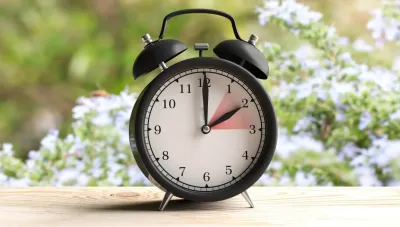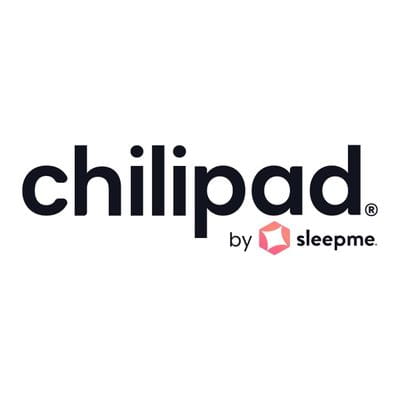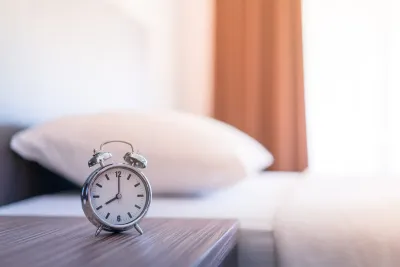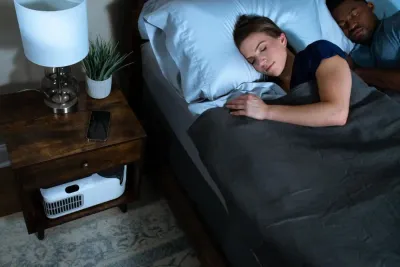Sleep Better During Daylight Saving Time: Strategies and Tips
Chilipad Editorial Team • Feb 24, 2025

Key Takeaways
- Clock Confusion: The time shift from daylight saving time can mess with your internal clock, making sleep feel off-sync for days.
- Sleep Strategy: Gradually adjusting your bedtime in the days leading up to the switch can help ease the transition.
- Light Leverage: Get morning sunlight to anchor your circadian rhythm and avoid bright light at night to wind down.
- Sleeping Tools: Sleep trackers and smart lighting can help you monitor and adjust your sleep patterns more smoothly.
- Routine Reset: Keeping a consistent sleep and wake time—even on weekends—helps your body bounce back faster.
With the arrival of warm weather and more sunshine, we can tell that Spring is on the way. However, in addition to the scent of freshly cut lawns and newly bloomed flowers, another yearly occurrence is just ahead: the beginning of Daylight Saving Time (DST).
As the change slowly gets closer, our days feel different, and we all anticipate this yearly change. However, we should be aware that daylight saving time can significantly impact our health and sleep patterns, regardless of whether we gain an hour (“spring forward”) or lose an hour (“falling back”).
Let's start by understanding what daylight saving time is, why it occurs, and when it happens. Then, we can dive into how it can affect your sleep, expert tips on preparing for it, and ways to improve your sleep.
Shop Award Winning Chilipad
Sleep deeper and by cooling your bed with our sleep systems and mattress toppers. Controls your bed temperature ranging from 55-115°F, so you sleep at your ideal temperature.
What is Daylight Saving?
During daylight saving time (DST), the clocks are set one hour forward from the standard time in the summer and then moved back again in the fall. The primary purpose of DST is to make better use of natural daylight, which means that sunrise and sunset times occur one hour later than standard time.
DST was first proposed by Benjamin Franklin in 1784. However, it wasn't widely adopted until the early 20th century. While most of the United States observes DST, two states don’t observe daylight savings time: Arizona and Hawaii. [1]
Related Blog: Year-Round Daylight Saving Time vs Standard Time
Why Do We Have Daylight Saving Time
There are a few reasons why we have daylight saving time.
One of the primary reasons behind Daylight Saving Time is energy conservation. During the summer months, the sun rises early and sets late, which means we require less artificial light in the morning and evening.
By moving our clocks ahead by an hour, we can take advantage of more natural sunlight and decrease our dependence on electricity, resulting in saving energy.
Second, Daylight Saving Time (DST) was implemented to reduce crime rates. Studies have demonstrated decreased criminal activity during the evening when there is more daylight. [2]
This could be attributed to people being more active when there is more light outside and possibly lower the incidences of crime. However, today, research is unclear whether or not that is still true in a post-industrial society.
Some people enjoy longer daylight hours in the evening as it provides them with additional time to engage in outdoor activities such as sports, gardening, taking a leisurely walk after work, or spending time with family enjoying the evening sunset.
Having more daylight in the evening can also promote relaxation and unwinding, thereby positively affecting mental health and overall well-being.
When to Change Daylight Saving Time
Many often ask, "When does daylight saving time start?" or "What time does it begin?" While the specific date changes annually, daylight saving time in the United States consistently starts at 2 a.m. on the second Sunday of March and concludes at 2 a.m. on the first Sunday of November.
Switching to Daylight Saving Time during the middle of the night on the weekend is designed to have the least possible impact on our regular routine. This strategy of switching does not interfere with work and other daytime activities.
However, the biannual alteration in our circadian rhythm has a negative effect on our regular sleep schedule, disrupting our internal body clock and leading to sleep disturbances.
The concept of transitioning during the late hours of the weekend aims to minimize the disturbance in our daily routines. This approach ensures that it doesn't hinder our professional responsibilities, such as work, during daylight.
However, the biannual disturbance to our circadian rhythm inflicted by this practice greatly disrupts our regular sleep schedule.
Did You Know: Studies indicate that individuals might encounter mild symptoms, such as struggling to adapt to a different morning routine. [3]
How to Adjust to Daylight Saving Time
Getting enough sleep can be challenging, especially with DST. Losing an hour of sleep can have a big impact on some people as it can be a lot to lose.
Adjusting to daylight savings time is different for everyone. Some are fortunate to adjust in a few days, while it may take longer for others.
Fortunately, there are a few daylight-saving tips on dealing with the time change.
Read More: The Dangers of Spring Forward: What You Should Know
Change Your Sleep Schedule
Given that we are adjusting our clocks for daylight saving time, its impact on us is unavoidable because light significantly affects our circadian rhythm, also known as our sleep/wake cycle. Our brains are conditioned to crave sleep at nightfall and to be alert when the sun rises.
The best way to adjust to daylight saving time is to gradually shift your sleep schedule back by 15 minutes each day for several days before DST begins.
Sleeping Tip: Maintaining a consistent sleep schedule by going to bed and waking up at the same times every day, including weekends, is the optimal approach.
For example, five days before daylight saving time, you can gradually adjust your bedtime. If you usually go to bed at 10 p.m. each night, you can divide the hour into five equal chunks.
If you want to prepare for daylight saving time, the best way is to adjust your sleep schedule over four days gradually. On the first day, try going to bed 12 minutes earlier than your usual bedtime.
Continue this routine on the second, third, and fourth days as well, making it easier for you to adjust to the time change when it happens.
10 pm Bedtime Example
- Day 1: Go to bed at 9:48 pm
- Day 2: Go to bed at 9:36 pm
- Day 3: Go to bed at 9:24 pm
- Day 4: Go to bed at 9:12 pm
- Day 5: Go to bed at 9:00 pm
The above schedule demonstrates the recommended bedtime for each day of the week, with a 12-minute earlier bedtime each consecutive day. This gradual modification can help you adjust your sleeping habits and improve the quality of your sleep leading up to DST.

Keep Naps Short
Naps can be a helpful tool during the adjustment period for Daylight Saving Time if you experience sleep deprivation. Consider taking short naps in the afternoon, no more than 20 minutes, to avoid feeling more tired and groggy when you wake up. [4]
For more information on the ideal length of naps, check out "How Long Should You Nap?" It can help you decide on the perfect duration.
Avoid Stimulating Substances
Limit or even avoid consuming caffeine and alcohol, as they can negatively impact sleep for some. Limiting their consumption a few hours before bedtime is best, ideally 4-6 hours prior.
To prepare for daylight saving time, experts recommend gradually reducing your caffeine intake in the afternoon and leading up to DST. Additionally, tobacco should also be avoided close to bedtime, as it can have an adverse effect on your sleep quality.
Exercise Early in the Day
Exercise early to force your body to “accept” the time change. Moderate activity and exercise during the day can help you sleep better.
It's a good idea to start exercising early to ease the transition during a time change. Whether it's walking, running, or biking, regular physical activity can enhance your sleep quality and assist your body in adapting to the new time schedule. [5]
Start with brief 30-minute sessions multiple times per week and slowly extend the length. However, withhold from exercising too close to bedtime.
Helpful Tip: Try to expose yourself to plenty of natural sunlight during the day whenever possible.
Gradually Adjust Your Dinner Time
Eating right before bed can disrupt your sleep, mainly if you consume a large meal. It's recommended to wait for three hours after eating. Eating dinner earlier can offset this disruption and make it easier for our bodies to adjust to the new time. It allows your body to digest the food, minimizing the possibility of experiencing indigestion, acid reflux, or an upset stomach at night.
Limit Screen Time
Screens emit blue light, which can interfere with the production of melatonin, a hormone that helps to regulate sleep. Exposing yourself to blue light before bed can make falling asleep and staying asleep difficult.
In addition, screens can be distracting and stimulating. When using a screen, it's easy to get caught up in what you're doing and lose track of time. This can make it difficult to wind down before bed.
If you're interested in learning more, we've written a blog on how blue light affects your sleep. You'll learn more with up-to-date research and discover simple strategies to minimize its disruptive effects.
Invest in Bed Cooling Technology
As we all know, daylight saving time can harm some individuals's sleep. One way to help your body adjust to the new time is to cool down your bed at night. Cooling your bed with the best cooling mattress topper, which can help you create an environment more conducive to sleep.
Whether you choose the Chilipad Dock Pro or Cube sleep system, you have complete control over the temperature of your mattress topper, which can range from 55 to 115 degrees.
Whether you're struggling to adjust to daylight saving time or want to improve your sleep quality, a bed cooling system can help.
Sleeping cooler at night provides numerous benefits. If You want to learn more, read our blog highlighting the benefits of sleeping cooler.
Final Thought
Daylight Saving Time can significantly affect our sleep patterns and overall well-being. However, if we understand its effects and follow the tips outlined above, we can minimize disruptions and ensure a smoother transition.
It's important to remember that quality sleep is crucial for our health and productivity. Therefore, we should take the necessary steps to maximize our sleep during these time changes.
References
[1] Barrera, D. (2022, November 5). Change of time in the USA: Which states do not have to change it and why. View Resource
[2] Doleac, J., & Sanders, N. (n.d.). Under the Cover of Darkness: Using Daylight Saving Time to Measure How Ambient Light Influences Criminal Behavior | Stanford Institute for Economic Policy Research (SIEPR). View Resource
[3] Monk, T. H., & Aplin, L. C. (1980). Spring and autumn daylight saving time changes: studies of adjustment in sleep timings, mood, and efficiency. Ergonomics, 23(2), 167–178. View Study
[4] Module 7. Napping, an Important Fatigue Countermeasure, Nap Duration | NIOSH | CDC. (2020, April 2). View Resource
[5] Kline C. E. (2014). The bidirectional relationship between exercise and sleep: Implications for exercise adherence and sleep improvement. American journal of lifestyle medicine, 8(6), 375–379. View Study









